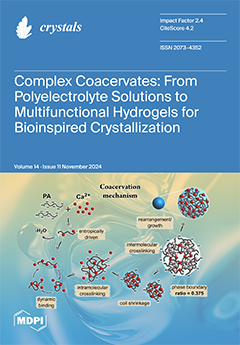Here, we report the structural, optical, magnetic, and dielectric properties of La
0.67Sr
0.33Mn
1-x-yZn
xCo
yO
3 manganite with various x and y values (0.025 < x + y < 0.20). The pure and co-doped samples are
[...] Read more.
Here, we report the structural, optical, magnetic, and dielectric properties of La
0.67Sr
0.33Mn
1-x-yZn
xCo
yO
3 manganite with various x and y values (0.025 < x + y < 0.20). The pure and co-doped samples are called S1, S2, S3, S4, and S5, with (x + y) = 0.00, 0.025, 0.05, 0.10, and 0.20, respectively. The XRD confirmed a monoclinic structure for all the samples, such that the unit cell volume and the size of the crystallite and grain were generally decreased by increasing the co-doping content (x + y). The opposite was true for the behaviors of the porosity, the Debye temperature, and the elastic modulus. The energy gap E
g was 3.85 eV for S1, but it decreased to 3.82, 3.75, and 3.65 eV for S2, S5, and S3. Meanwhile, it increased and went to its maximum value of 3.95 eV for S4. The values of the single and dispersion energies (E
o, E
d) were 9.55 and 41.88 eV for S1, but they were decreased by co-doping. The samples exhibited paramagnetic behaviors at 300 K, but they showed ferromagnetic behaviors at 10 K. For both temperatures, the saturated magnetizations (M
s) were increased by increasing the co-doping content and they reached their maximum values of 1.27 and 15.08 (emu/g) for S4. At 300 K, the co-doping changed the magnetic material from hard to soft, but it changed from soft to hard at 10 K. In field cooling (FC), the samples showed diamagnetic regime behavior (M < 0) below 80 K, but this behavior was completely absent for zero field cooling (ZFC). In parallel, co-doping of up to 0.10 (S4) decreased the dielectric constant, AC conductivity, and effective capacitance, whereas the electric modulus, impedance, and bulk resistance were increased. The analysis of the electric modulus showed the presence of relaxation peaks for all the samples. These outcomes show a good correlation between the different properties and indicate that co-doping of up to 0.10 of Zn and Co in place of Mn in La:113 compounds is beneficial for elastic deformation, optoelectronics, Li-batteries, and spintronic devices.
Full article





